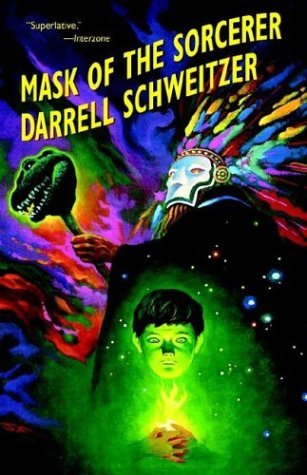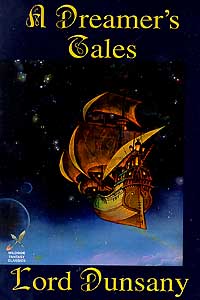ON WRITING FANTASY: Setting & the Five Senses
 “The city is a different place in the daylight, bright banners waving from towers, houses likewise bright with hangings and with designs painted on walls and roofs. The ships of the river unload by day, and the streets are filled with the babble of tongues, while traders and officials and barbarians and city wives all haggle together. It is a place of sharp fish smells and strange incense and leather and wet canvas and unwashed rivermen who bring outlandish beasts from the villages high in the mountains, near the birthplace of the river.”
“The city is a different place in the daylight, bright banners waving from towers, houses likewise bright with hangings and with designs painted on walls and roofs. The ships of the river unload by day, and the streets are filled with the babble of tongues, while traders and officials and barbarians and city wives all haggle together. It is a place of sharp fish smells and strange incense and leather and wet canvas and unwashed rivermen who bring outlandish beasts from the villages high in the mountains, near the birthplace of the river.”
— Darrell Schweitzer, MASK OF THE SORCERER
“I have never seen a city in the world so beautiful as Merimna seemed to me when I first dreamed of it. It was a marvel of spires and figures of bronze, and marble fountains, and trophies of fabulous wars, and broad streets given over wholly to the Beautiful. Right through the centre of the city there went an avenue fifty strides in width, and along each side of it stood likenesses in bronze of the Kings of all the countries that the people of Merimna had ever known. At the end of that avenue was a colossal chariot with three bronze horses driven by the winged figure of Fame…”
— Lord Dunsany, “The Sword of Welleran”
“Beyond the forest opened a feral country, where many things grew, but out of control and out of a pure determination to be born. Here the huge-thorned roses bloomed spotted as cats on the briars, the apples were salt, and the fruit of the quince tree was like wormwood. Bright birds lived in the thickets but they had no song. The native beasts were savage, but they did not often hunt men, for men did not often come there to oblige them.”
— Tanith Lee, DEATH’S MASTER
Where in the world are we?
When it comes to Fantasy Fiction the importance of a unique and original Setting cannot be overstated. Every story has to take place SOMEWHERE…and the Where of a story often determines every other aspect, including Who, What, and Why. Instead of relying on a re-creation of the “real world,” fantasy writers must create new worlds, which demands a whole new set of skills.
 Perhaps the most important aspect of creating a good fantasy setting is to avoid the clichés. The standard pseudo-medieval setting is so tired and played out, it takes a writer with true genius to invest it with fresh relevance. George R. R. Martin does it in A SONG OF ICE AND FIRE; Darrell Schweitzer does it in his tales of questing knights; you may have your own examples. Yet a fantasy writer has the entirety of his/her imagination to draw upon…the possibilities for new and inventive fantasy worlds is virtually limitless. The only boundaries are the parameters of the writer’s imagination.
Perhaps the most important aspect of creating a good fantasy setting is to avoid the clichés. The standard pseudo-medieval setting is so tired and played out, it takes a writer with true genius to invest it with fresh relevance. George R. R. Martin does it in A SONG OF ICE AND FIRE; Darrell Schweitzer does it in his tales of questing knights; you may have your own examples. Yet a fantasy writer has the entirety of his/her imagination to draw upon…the possibilities for new and inventive fantasy worlds is virtually limitless. The only boundaries are the parameters of the writer’s imagination.
The “weirdness” factor is something to consider, as is the “magic” factor, the “nonhuman” factor, and the “technology” factor. Which of these factors does your world include, and in what ratio? Is it primarily a magical reality, or simply an alternate world that is fantastic for reasons that have nothing to do with magic? Are the denizens human, non-human, or a combination? Is there technology in this world, and if so what role does it play in the natives’ lives? If there is magic, what are its rules? Even the wildest and weirdest setting must abide by its own set of rules. The worst thing a writer could do would be to create a world where “anything goes.” The trick is to make your fantasy world as realistic and consistent as the real world. Perhaps even moreso.
In order to give your fantasy setting a sense of realism and consistency, i.e. to make it believable to your readers, you need to figure out your rules ahead of time. You need to know this world as well as you know your own back yard…no, even better. You need to know things that will never come up in the stories you’re writing about this world…you need to have a whole iceberg in mind but only show the reader the tip. The bulk of the iceberg (i.e. your rules) will remain hidden under water (i.e. in your own notes).
 Consider the land itself: What is the geography like? Islands? Continents? Mountains or plains? Forests or deserts?
Consider the land itself: What is the geography like? Islands? Continents? Mountains or plains? Forests or deserts?
Then consider the population: Do they live in cities? Underground warrens? Cloud castles? Floating city-ships? Consider daily life in these population centers. Likewise, consider life in the wilderness of your world. Who/what are the inhabitants of your wild places?
Your key to all these questions comes back to Character. Your characters will be the readers’ windows into the world you have created.
The best way to make your setting come to life in a reader’s mind is to appeal to the Five Senses: Sight, Hearing, Smell, Touch, and Taste. Remember that genius lies in the details…and so does effective imagery. And that’s what creating a fascinating setting is all about: Imagery. You want your setting to take form in the reader’s mind. You want the forests, oceans, cities, battlefields, towers, orchards, mountains, etc. to manifest themselves in your readers’ imaginations. The only way to do that is to create imagery by appealing to the five senses. Don’t rely simply on visual descriptions.
Remember where your characters are—especially your VIEWPOINT characters. Filter your readers’ perceptions through those characters, by drawing attention to what the characters are noticing themselves. Even things they notice on the fringe of their senses can help you set a mood, establish a tone, and bring your setting to life.
What does it smell like? Remember that cities (especially ancient cities) are loaded with smells…usually unpleasant smells like horse dung, sweat, and gutter sludge. Likewise, the splendid palace of a king will probably be redolent with garden blossoms, night-blooming jasmine, wafting torch fumes, and the cologne of fawning courtesans.
 What does it sound like? Remember the sounds that fill your world. Describe them with clever figurative language, i.e. metaphor and simile. A direct description every now and then doesn’t hurt either. The thunder of horses’ hooves, the breath of the evening wind among the leaves of trees, the sigh of a metal blade as it slips from a scabbard, the strange cries of night beasts lurking in a haunted swamp.
What does it sound like? Remember the sounds that fill your world. Describe them with clever figurative language, i.e. metaphor and simile. A direct description every now and then doesn’t hurt either. The thunder of horses’ hooves, the breath of the evening wind among the leaves of trees, the sigh of a metal blade as it slips from a scabbard, the strange cries of night beasts lurking in a haunted swamp.
What does it taste like? Consider the tastes that touch your characters’ tongues. The bitter tang of ale, the sweet tang of a young wine, the coppery flavor of blood, the foulness of spoiled meat eaten to avoid starvation. Make your reader taste the good and bad flavors of your world.
What does it feel like? Textures are everywhere. Evoke the roughness of tree bark, the smooth marble of a palace floor, the slickness of gossamer silk on the shoulders of a queen, the sweaty grip of a fist on the hilt of a sword. The grains of sand in a warrior’s boot, rubbing his heel to rawness. The pleasure of a cool wind caressing skin…the cold violence of a dive into winter water.
What does it look like? This is perhaps the easiest type of image to create, so save it for last. In other words, ask yourself “Am I appealing to other senses besides sight?” It is crucial to give your reader a mental image to carry through the story with him. But you cannot rely on this single sense to truly bring your setting to life. You can describe all the diamond-bright towers and blood-dark seas you want, but if your reader cannot smell, taste, touch, and feel your world, no amount of beautiful prose will save you from an underdeveloped setting.
To be completely immersed in a fantasy world (and that is the goal of EVERY fantasy writer), you must command the five senses of your reader. The best way to do this is a combination of figurative language and direct description that appeals to all five senses.
Do not attempt to make up your fantasy world “as you go.” Think about it; take notes; dwell upon it; you must KNOW this world before you can bring it to life through your writing.
 If you succeed in mastering the imagery of the five senses, you can take even the most well-trodden fantasy settings and bring it to life. You need not re-invent the wheel every time you create a new world…but you must use all the tools in your writer’s toolbox to make that world REAL.
If you succeed in mastering the imagery of the five senses, you can take even the most well-trodden fantasy settings and bring it to life. You need not re-invent the wheel every time you create a new world…but you must use all the tools in your writer’s toolbox to make that world REAL.
One last thing: Avoid long blocks of text where you describe the world in excruciating detail. These types of long-winded exposition will make editors (and readers) stop reading your story. Nobody cares about the world you’ve created…THEY CARE ABOUT YOUR CHARACTERS.
So reveal your world in carefully-chosen moments by giving your readers a “ride” in the five senses of your characters. You can also reveal the details of your setting (especially political and cultural information) in character dialogue. Always avoid “pausing” your story to describe the world in which it is set. Instead, describe it as you go, in ways that are relevant to the characters and their actions. In other words, don’t bore your reader with passages that read like they came from a textbook.
Don’t pour an ocean of setting information on your readers; they will drown. It’s much better to rain setting details on them a few at a time.
Four Steps to a Great Setting: Imagine it; plan it; populate it; bring it to life through sensory images.
Another great article! I particularly struggle with describing scenes in the five senses when I’m writing. Often, I’m too wrapped up in ‘what happened next,’ and I focus only on sight and sound. It’s more difficult for me to feel like I’m actually there experiencing these things along with the characters. I’ve heard that this is something many writers struggle with since we live in a television/cinema age: we’re used to having our stories conveyed to us through sight and sound, and too used to looking in on them rather than experiencing them firsthand.
I’ve started doing an exercise in which I stop writing and get up from my chair, then imagine where things and people would be in the room. What do things smell like? What would it feel like if I touched certain things? What ambient sensations are there around me? This really helps me insert myself into the middle of a scene rather than just feeling like a removed watcher seeing the scene unfold.
[…] essays are just that damn good. The latest installment by John Fultz explores the use of “Setting and the Five Senses“ to create a lush and realistic fantasy world. Whether it is the most outré alien vista […]
Hey, Daniel,
You’re definitely on the right track, man. Anything you can do to maximize your sensual imagery is great…and sometimes that means exposing your senses to the very things you are going to be writing about. For instance, during a crucial scene set in a tavern where two characters were conversing and drinking wine, I drank wine before and during the writing of that scene. (I don’t normally drink at all.) Before writing a forest scene, it’s ideal to spend some time in the forest, consciously experiencing what it does to your senses. Recently I’ve been working on a novel where my Native American protagonists of centuries ago are eating buffalo. So while on a business trip recently I was able to sample a bison steak at one of Chicago’s leading restaurants. I was literally tasting what my characters were eating and tasting CONSTANTLY in the novel.
A writer’s job is to observe; then go back to his work and capture what he has observed. When it comes to fiction, this observation must involve all five senses.
Cheers,
John
[…] writing fantasy right here on the Black Gate site, you’ve been missing out! His entry on setting and sensory details from yesterday is a great place to start, and it fits in perfectly with today’s discussion […]
Bison steak? I’ve had the chance to eat venison, elk, mutton, duck, lamb, and even pigeon on one memorable occasion in Paris, but never bison steak.
Though I have had bison jerky, I doubt it compares.
Great article! It makes sense to drop information gradually rather than pelt the reader with it all up front or at once.
[…] Check out Black Gate’s On Writing Fantasy: Setting and the Five Senses. […]